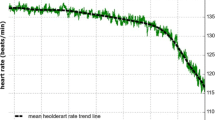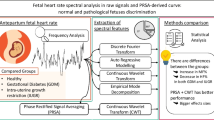Abstract
Cardiotocography is the most diffused prenatal diagnostic technique in clinical routine. The simultaneous recording of foetal heart rate (FHR) and uterine contractions (UC) provides useful information about foetal well-being during pregnancy and labour. However, foetal electronic monitoring interpretation still lacks reproducibility and objectivity. New methods of interpretation and new parameters can further support physicians’ decisions. Besides common time-domain analysis, study of the variability of FHR can potentially reveal autonomic nervous system activity of the foetus. In particular, it is clinically relevant to investigate foetal reactions to UC to diagnose foetal distress early. Uterine contraction being a strong stimulus for the foetus and its autonomic nervous system, it is worth exploring the FHR variability response. This study aims to analyse modifications of the power spectrum of FHR variability corresponding to UC. Cardiotocographic signal tracts corresponding to 127 UC relative to 30 healthy foetuses were analysed. Results mainly show a general, statistically significant (t test, p<0.01) power increase of the FHR variability in the LF 0.03–0.2 Hz and HF 0.2–1 in correspondence of the contraction with respect to a reference tract set before contraction onset. Time evolution of the power within these bands was computed by means of time-varying spectral estimation to concisely show the FHR response along a uterine contraction. A synchronised grand average of these responses was also computed to verify repeatability, using the contraction apex as time reference. Such modifications of the foetal HRV that follow a contraction can be a sign of ANS reaction and, therefore, additional, objective information about foetal reactivity during labour.







Similar content being viewed by others
References
Bannicki J, Dirner JAS, Hertwig K, Dudenhousen JW (1998) Computerized cardiotocography following vibroacoustic stimulation of premature fetuses. Gynecol Obstet Invest 48:73–76
Bernardes J, Costa-Pereira A, Ayres-De-Campos D, Van Geijn HP, Pereira-Leite L (1997) Evaluation of interobserver agreement of cardiotocograms. Int J Gynecol Obstet 57:33–37
Blix E, Sviggum O, Koss KS, Øian P (2003) Inter-observer variation in assessment of 845 labour admission tests: comparison between midwives and obstetricians in the clinical setting and two experts. Br J Obstet Gynaecol 110(1):1–5
Cao H, Lake DE, Chisholm CA, Ferguson JE, Griffin MP, Moorman JR (2003) Toward quantitative monitoring of human cardiotocography during labor. In: Proceedings of the 25th annual international conference of the IEEE EMBCancun S, Mexico. September 17–21
Cerutti S, Civardi S, Bianchi A, Signorini MG, Ferrazzi E, Pardi G (1989) Spectral analysis of antepartum heart rate variability. Clin Phys Meas 10(suppl B):27–31
Cerutti S, Baselli G, Bianchi A, Signorini MG (1992) Spectral techniques of analysis for blood pressure and heart rate signals. In: Di Rienzo M et al (eds) Blood pressure and heart rate variability. IOS press, Amsterdam, pp 39–55
Clifford GD, Tarassenko L (2005) Quantifying errors in spectral estimates of HRV due to beat replacement and resampling. IEEE Trans Biomed Eng 52(4):630–638
Dawes GS, Moulden M, Redman CW (1983) Computerized analysis of antepartum fetal heart rate. Amer J Obstet Gynecol 173(4):1353–1354
Divon MY, Muska Y, Platt LD, Paldi E (1984) Increased beat to beat variability during uterine contractions: a common association in uncomplicated labor. Am J Obstet Gynecol 149:893–896
Divon MY, Torres FP, Yeh SY, Paul RH (1985) Autocorrelation techniques in fetal monitoring. Am J Obstet Gynecol 151:2–6
Donker DK, Van Geijn HP, Hasman A (1993) Interobserver variation in the assessment of fetal heart rate recordings. Eur J Obstet Gynecol Reprod Biol 52:21–28
FIGO Study Group on the Assessment of New Technology (1995) FIGO news. Intrapartum surveillance: recommendations on current practice and overview of new developments. Int J Gynecol Obstet 49:213–221
Figueras F, Albela S, Bonino S, Palacio M, Barrau E, Hernandez S, Casellas C, Coll O, Cararach V (2005) Visual analysis of antepartum fetal heart rate tracings: inter- and intra-observer agreement and impact of knowledge of neonatal outcome. J Perinat Med 33(3):241–245
van Geijn HP (1987) The European community project Perinatal monitoring. J Perinat Med 15(4):367–368
van Geijn HP, Lachmeijer AM, Copray FJ (1993) European multicentre studies in the field of obstetrics. Eur J Obstet Gynecol Reprod Biol 50(1):5–23
Goeshen K (1998) Cardiotocografia pratica. V edizione CIC Edizioni Internazionali, Roma
Griffin RL, Caron FJM, Van Geijn HP (1985) Behavioral states in the human fetus during labor. Am J Obstet Gynecol 152(7Pt 1):828–833
Gudmundsson S, Olofsson P (2004) Acute changes of cerebral venous blood flow in growth-restricted human fetuses in response to uterine contractions. Ultrasound Obstet Gynecol 24:516–521
Hataa T, Aokib S, Manabeb A, Kanenishia K, Yamashiroc C, Tanakaa H, Yanagiharaa T (2000) Subclassification of small-for-gestational-age fetus using fetal Doppler velocimetry. Gynecol Obstet Invest 49(4):236–239
Kamath MV, Fallen EL (1993) Power spectral analysis of heart rate variability: a noninvasive signature of cardiac autonomic function. Crit Rev Biomed Eng 21(3):245–311
Kimura Y, Okamura K, Yajima A (1996) Spectral analysis of beat-to-beat intervals of the fetal heart obtained by Doppler ultrasound. Gynecol Obstet Invest 41:5–9
Laguna P, Moody GB, Mark RG (1998) Power spectral density of unevenly sampled data by least-square analysis: performance and application to heart rate signals. IEEE Trans Biomed Eng 45(6):698–715
Lawson GW, Belcher R, Dawes GS, Redman CW (1983) A comparison of ultrasound (with autocorrelation) and direct electrocardiogram fetal heart rate detector systems. Amer J Obstet Gynecol 147(6):721–722
Li H, Gudmundsson S, Olofsson P (2003) Acute increase of umbilical artery vascular flow resistance in compromised fetuses provoked by uterine contractions. Early Hum Dev 74:47–56
Lin CC, Vassallo B, Mittendorf R (2001) Is intrapartum vibroacoustic stimulation an effective predictor of fetal acidosis? J Perinat Med 29(6):506–512
Magenes G, Signorini MG, Arduini D (2002) Central and autonomic regulation of fetal heart rate: nonlinear analysis after vibroacoustic stimulation. In: Proceedings of the second joint EMBS/BMES conference. Houston, TX, USA pp 23–26
Magenes G, Signorini MG, Arduini D, Cerutti S (2004a) Fetal heart rate variability due to vibroacoustic stimulation: linear and nonlinear contribution. Meth Inform Med 43(1):47–51
Magenes G, Pedrinazzi L, Signorini MG (2004b) Identification of fetal sufferance antepartum through a multiparametric analysis and a support vector machine. In: Proceedings of the 26th annual international conference of the IEEE EMBS. San FranciscoA, USA. September 1–5
Mantel R, Van Geijn HP, Caron FJM, Swartjes JM, Van Woerden EE, Jongsma HW (1990a) Computer analysis of antepartum fetal heart rate: 1. baseline determination. Int J Biomed Comput 25:261–260
Mantel R, Van Geijn HP, Caron FJM, Swartjes JM, Van Woerden EE, Jongsma HW (1990b) Computer analysis of antepartum fetal heart rate: 2. Detection of accelerations and decelerations. Int J Biomed Comput 25:273–286
Martin CB Jr (1982) Physiology and clinical use of fetal heart rate variability. Clin Perinatol 9(2):339–352
Members of Task Force of the European Society of Cardiology and the North American Society of Pacing and Electrophysiology (1996) Guidelines. Heart rate variability—standards of measurement, physiological interpretation, and clinical use. Eur Heart J 17:354–381
Nijhuis JG (2003) Fetal behavior. Neurobiology of aging, pp S41–S46
Odd H, Jensen R, Narverud G (1994) Fetal heart rate decelerations and umbilical cord blood gas values. Eur J Obstet Gynecol Reprod Biol 53:103–106
Ohta T, Okamura K, Kimura Y, Suzuki T, Watanabe T, Yasui T, Yaegashi N, Yajima A (1999) Alteration in the low-frequency domain in power spectral analysis of fetal heartbeat fluctuations. Fetal Diagn Ther 14:92–97
Oppenheimer LW, Lewinsky RM (1994) Power spectral analysis of fetal heart rate. Baillère’s Clin Obstet Gynecol 8(3):643–661
Padhye NS, Duan Z, Verklan MT (2004) Response of fetal heart rate to uterine contractions. In: Proceedings of the 26th annual international conference of the IEEE EMBS. San Francisco, CA, USA. September 1–5
Peter P, Toth D, Jothivijayarani A (1999) Obstetrics: intrapartum monitoring and management. University of Iowa Family Practice Handbook, 3rd edn, Chapter 8; 20/07/1999
Rantonen T, Ekholm E, Siira S, Metsala T, Leino R, Ekblad U, Valimaki (2001) Periodic spectral components of fetal heart rate variability reflect the changes in cord arterial base deficit values: a preliminary report. Early Hum Dev 60(3):233–238
Romano M (2004) Pre- and neo-natal diagnostic: multiparametric analysis. PhD Thesis in Bioengineering. University ‘Federico II’ of Naples, Italy
Romano M, Bracale M, Cesarelli M, Campanile M, Bifulco P, De Falco M, Sansone M, Di Lieto A (2006) Antepartum cardiotocography: a study of fetal reactivity in frequency domain. Comput Biol Med J (in press)
Salamalekis E, Vitoratos N, Loghis C, Panayotopoulos N, Kassanos, Creatsas G (1999) Evaluation of fetal heart rate patterns during the second stage of labor through fetal oximetry. Gynecol Obstet Invest 48(3):151–154
Salamalekis E, Thomopoulos P, Giannaris D, Salloum I, Vasios G, Prentza A, Koutsouris D (2002) Computerised intrapartum diagnosis of fetal hypoxia based on fetal heart rate monitoring and fetal pulse oximetry recordings utilising wavelet analysis and neural networks. BJOG 109:1137–1142
Senat MV, Schw¨ arzler P, Alcais A (2000) Ville longitudinal Y changes in the ductus venosus, cerebral transverse sinus and cardiotocogram in fetal growth restriction. Ultrasound Obstet Gynecol 16:19–24
Signorini MG, Magenes G, Cerutti S, Arduini D (2003) Linear and nonlinear parameters for the analysis of fetal heart rate signal from cardiotocographic recordings. IEEE Trans Biomed Eng 50(3):365–375
Siira SM, Ojala TH, Vahlberg TJ, Vahlberg J, Jalonen JO, Valimaki IA, Rosen KG, Ekholm EM (2005) Marked fetal acidosis and specific changes in power spectrum analysis of fetal heart rate variability recorded during the last hour of labour. BJOG 112:418–423
Van Geijn HP (1996) Developments in CTG analysis. Baillieres Clin Obstet Gynaecol 10(2):185–209
Van Rovenswaaij-Arts CMA, Kollèe LAA, Hopman JCW, Stoelinga GB, Van Geijn HP (1993) Heart rate variability. Ann Intern Med 118(6):436–447
Van Woerden EE, Van Geijn HP (1994) Factors influencing the fetal heart rate. A critical appraisal of fetal surveillance. Excerpta Medica (Cap Amsterdam) 27:211–219
Various authors (1994) HP Series M135x technical reference. Hewlett-Packard, Boeblingen, Germany
Various authors (1995) Fetal monitor test—a brief summary, Hewlett-Packard, Boeblingen, 1–6
Yu Z-Y, Lumbers ER (2000) Effect of cold on fetal heart rate and its variability. Clin Exp Pharmacol Physiol 27:607–611
Zhuravlev YE, Rassi D, Mishin AA, Emery SJ (2002) Dynamic analysis of beat-to-beat fetal heart rate variability recorded by squid magnetometer: quantification of sympatho-vagal balance. Early Hum Dev 66:1–10
Zimmer EZ, Paz Y, Copel JA, Weiner Z (1998) The effect of uterine contractions on intrapartum fetal heart rate analyzed by a computerized system. Am J Obstet Ginecol 178(3):436–440
Author information
Authors and Affiliations
Corresponding author
Rights and permissions
About this article
Cite this article
Romano, M., Bifulco, P., Cesarelli, M. et al. Foetal heart rate power spectrum response to uterine contraction. Med Bio Eng Comput 44, 188–201 (2006). https://doi.org/10.1007/s11517-006-0022-8
Received:
Accepted:
Published:
Issue Date:
DOI: https://doi.org/10.1007/s11517-006-0022-8




